Different developers -> different systems architecture. Each one has it's own pros and cons.Makes absolutely no sense, lol, smh.
You are using an out of date browser. It may not display this or other websites correctly.
You should upgrade or use an alternative browser.
You should upgrade or use an alternative browser.
Su-30, Su-33, Su-34 and Su-35 News thread, pictures and discussion
- Thread starter overscan (PaulMM)
- Start date
Ainen
I really should change my personal text
- Joined
- 25 August 2011
- Messages
- 1,237
- Reaction score
- 1,649
If i understand correctly, UV gives best possible clarity for launch event(SRF ingition in UV is immediately obvious)&lowers number of false positives.
IR gives a more useful picture overall(depends on resolution of course), and can track quite well missiles after their burnout.
Both have their own atmospheric quirks, but overall UV is more popular.
Radar MAWs solution is rarer, has limited range, requires more power and emits, but excludes false positives as a class.
IR gives a more useful picture overall(depends on resolution of course), and can track quite well missiles after their burnout.
Both have their own atmospheric quirks, but overall UV is more popular.
Radar MAWs solution is rarer, has limited range, requires more power and emits, but excludes false positives as a class.
Joint Soviet Fighter
ACCESS: Secret
- Joined
- 14 January 2025
- Messages
- 247
- Reaction score
- 277
Russia always cheaps out somewhere.Different developers -> different systems architecture. Each one has it's own pros and cons.
Ridiculous.
Joint Soviet Fighter
ACCESS: Secret
- Joined
- 14 January 2025
- Messages
- 247
- Reaction score
- 277
If i understand correctly, UV gives best possible clarity for launch event(SRF ingition in UV is immediately obvious)&lowers number of false positives.
IR gives a more useful picture overall(depends on resolution of course), and can track quite well missiles after their burnout.
Both have their own atmospheric quirks, but overall UV is more popular.
Radar MAWs solution is rarer, has limited range, requires more power and emits, but excludes false positives as a class.
UV is also much cheaper but is completely useless against nonburning missiles.
yeah, cuz IR MAWS for Su-35S was designed by foreign company...Russia always cheaps out somewhere.
Ridiculous.
Joint Soviet Fighter
ACCESS: Secret
- Joined
- 14 January 2025
- Messages
- 247
- Reaction score
- 277
That's not the point, at all.yeah, cuz IR MAWS for Su-35S was designed by foreign company...
Well, in the light of the fact both systems have been designed in Russia, you have no point at all.That's not the point, at all.
Joint Soviet Fighter
ACCESS: Secret
- Joined
- 14 January 2025
- Messages
- 247
- Reaction score
- 277
The point is that you don't penny-pinch when it comes to protecting something as expensive as The Su-57, lol, smh, otherwise your longstanding penchant for being cheap invariably costs more money when the platform is lost, as has been seen with countless T-72B3s, for example.Well, in the light of the fact both systems have been designed in Russia, you have no point at all.
On paper, giving the gunner his own Sosna-U thermal sight sounds great, but unless the commander is provided with his own thermal imager, he's not going to be able to see guys hiding in the bushes, etc., with Javelin atgms, thereby making the destruction of said tank monumentally easier, which also means that you just threw away an expensive Sosna-U for nothing, & for aircraft it's even worse. I mean, plenty of Russian aircraft with rwr & Khibiny have been lost both to MANPADS & The Patriot, etc., owing to their apparent inability to discern that they have been fired upon by said radar-guided SAM until it is either too late or not at all, & given that those missiles are typically not burning at the ranges of interception, it means that your uv-based MAWS is completely useless, so there goes more money down the drain.
Conversely, NATO manages the battlespace with AWACS that can alert pilots that there are inbound missiles & fighters such as The F-35 have the latest-&-greatest elint/isr/rwr systems that money can buy, I guess, with their own electronic warfare defensive systems that are backed up by dedicated standoff jamming aircraft, &, crucially, The F-35 also has The DAS that can identify missiles that are no longer burning (or at least that's the belief/sales pitch, anyway) but not everyone can afford to field all of this stuff, so Russia has to make a choice - do they continue to try to field an expensive Su-57 that is rather meh from a stealth standpoint & also not provide it with the kind of defensive measures to give it the best chance of survival in order to be able to carry more missiles (woo), or do they do everything possible within monetary constraints to reduce the rcs of The Felon, or another aircraft, to the largest extent & provide it/them with a DAS-like system at the expense, perhaps, of the two side-looking AESA radars & the uv-based MAWS, even if it also means a reduced payload? For me, the answer is unquestionably the latter, especially as their DAS already exists, albeit in limited quantities, at the moment, & on the wrong platform, but this does not appear to be the thinking in Moscow/at Sukhoi, so whatever.
Just because you can detect the SAM doesn't necessary mean you can evade it, especially if you are within the NEZ.I mean, plenty of Russian aircraft with rwr & Khibiny have been lost both to MANPADS & The Patriot, etc., owing to their apparent inability to discern that they have been fired upon by said radar-guided SAM until it is either too late or not at all, & given that those missiles are typically not burning at the ranges of interception, it means that your uv-based MAWS is completely useless, so there goes more money down the drain.
Su-57 has many things that F-35 doesn't have such as the side-looking AESA radars, DIRCM system, L-band arrays.Conversely, NATO manages the battlespace with AWACS that can alert pilots that there are inbound missiles & fighters such as The F-35 have the latest-&-greatest elint/isr/rwr systems that money can buy, I guess, with their own electronic warfare defensive systems that are backed up by dedicated standoff jamming aircraft, &, crucially, The F-35 also has The DAS that can identify missiles that are no longer burning (or at least that's the belief/sales pitch, anyway) but not everyone can afford to field all of this stuff, so Russia has to make a choice - do they continue to try to field an expensive Su-57 that is rather meh from a stealth standpoint & also not provide it with the kind of defensive measures to give it the best chance of survival in order to be able to carry more missiles (woo), or do they do everything possible within monetary constraints to reduce the rcs of The Felon, or another aircraft, to the largest extent & provide it/them with a DAS-like system at the expense, perhaps, of the two side-looking AESA radars & the uv-based MAWS, even if it also means a reduced payload? For me, the answer is unquestionably the latter, especially as their DAS already exists, albeit in limited quantities, at the moment, & on the wrong platform, but this does not appear to be the thinking in Moscow/at Sukhoi, so whatever.
Sure DAS is cool too but an UV sensor also have benefit such as low false alarm, can work even when there is fog/cloud.
Su-57 is not as stealthy as F-35 but it is much faster, more agile and has bigger weapon bay. The philosophy of Russia and USA are not the same.
So, the Russian MoD ordered IR MAWS for the upgraded version of its 4th gen. fighter, but at the same time Russian MoD is too greedy (or poor?) to afford similar system to be developed and installed on its promising premiere fighter jet? Because...they ordered only one IIR sight to be installed on the modernized T-72!The point is that you don't penny-pinch when it comes to protecting something as expensive as The Su-57...
Tadaaam!
I very much doubt that about The Su-35 MAWS, especially as none of the information about the various defensive systems even mentions the method of detection, & in terms of lwr, I understand the overall concept, but at that kind of range (30 km, max), you're probably already dead, anyway.
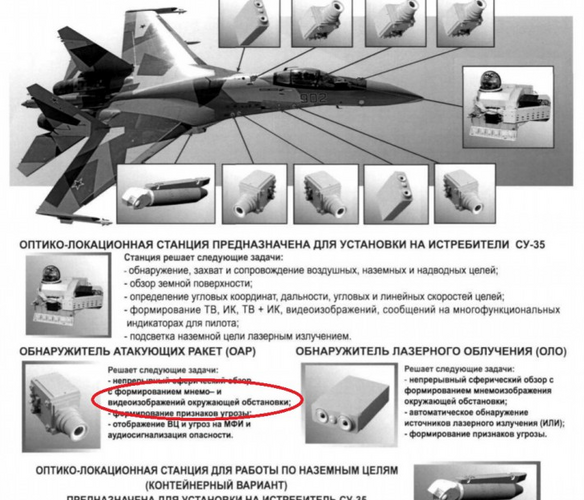
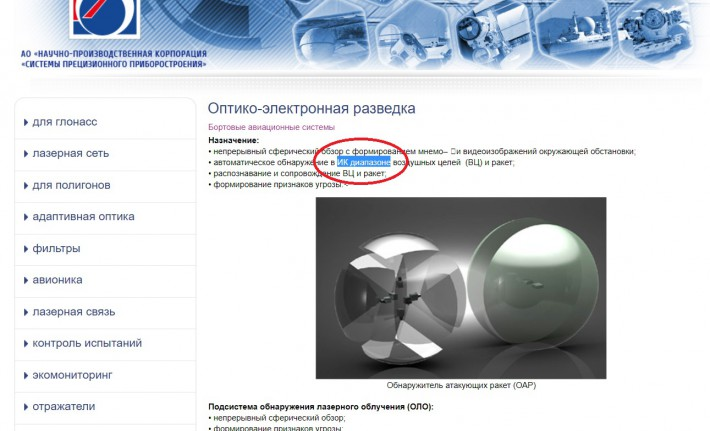
OAR for Su-35 is IIR.
Joint Soviet Fighter
ACCESS: Secret
- Joined
- 14 January 2025
- Messages
- 247
- Reaction score
- 277
And if you cannot detect The SAM you have absolutely zero chance of evading it.Just because you can detect the SAM doesn't necessary mean you can evade it, especially if you are within the NEZ.
Su-57 has many things that F-35 doesn't have such as the side-looking AESA radars, DIRCM system, L-band arrays.
Sure DAS is cool too but an UV sensor also have benefit such as low false alarm, can work even when there is fog/cloud.
Su-57 is not as stealthy as F-35 but it is much faster, more agile and has bigger weapon bay. The philosophy of Russia and USA are not the same.
I actually think that The Su-57 has some really cool features like the levcons, the external weapons bays that store The R-73s/74s without compromising the rcs of the plane, & The DIRCM system (not good for the overall rcs, though), but there are too many other problems with the overall design that seriously undermine its attempt at being a true stealth platform that have been discussed on this forum for many years, now, so there's no point in repeating them, here.
Overall, I'm not saying that Russia has to be like China & just copy everything American, as there's nothing wrong with wanting to build an aircraft with more maneuverability, for example, unless that & other requirements like the two weapons bays contribute to making the plane much more visible on radar, thereby rendering the agility & larger storage capability completely irrelevant when The Su-57 is picked off at considerable range & also doesn't have the required defensive systems in order to survive, which is especially important given that only 76 of these things were ordered.
Ironically, however, if you could field an aircraft with such an rcs that negates the radar advantage of The F-22/F-35, then that dogfighting capability would arguably make the difference in such a confrontation, but your rcs has to be at such a level so as to enable you to first get within the needed range.
As for DAS vs uv sensors, I would personally opt for one system that provides the best of both worlds, so to speak, even at the expense of the two side looking AESA radars, for starters, or even not using an AESA, at all, with the idea being that when two truly stealth planes meet, radar becomes irrelevant, but, again, that's just me.
Bottom line - there are ways to close the gap, even with budgetary constraints, hence as to why I continue to find Russian design choices to be very bizarre.
*shrugs*
Joint Soviet Fighter
ACCESS: Secret
- Joined
- 14 January 2025
- Messages
- 247
- Reaction score
- 277
So, the Russian MoD ordered IR MAWS for the upgraded version of its 4th gen. fighter, but at the same time Russian MoD is too greedy (or poor?) to afford similar system to be developed and installed on its promising premiere fighter jet? Because...they ordered only one IIR sight to be installed on the modernized T-72!
Tadaaam!
No. The T-72B3 example was used to highlight the design choices that only resulted in the loss of the newer technology instead of actually bringing the tank up to modern standards.
Joint Soviet Fighter
ACCESS: Secret
- Joined
- 14 January 2025
- Messages
- 247
- Reaction score
- 277
As I don't speak Russian, I have to rely on Google translate, which yields the following for the two posted images:
Attack Missile Detector (AMD)
Solves the following tasks:
- continuous etheric ebaor
With the formation of mnemonics
video imaging of the surrounding environment;
- formation of signs of threat
- display of the computing center & threats on the MFI & audio signaling hazards.
Optical-electronic reconnaissance
Airborne systems
Purpose:
- continuous spherical view of the formation with mnemonic C video images of the surrounding environment;
- automatic detection of air targets (AT) & missiles in the IR range,
- recognition & tracking of air defense systems & missiles,
- formation of signs of threat.
I'm sure that there are translating errors (lol at "mnemonic", in particular), but this is the best that I can do. If you've ever seen the footage from The IRST, though, you should be well aware that that sensor does not make use of thermal imaging (iir). It's really a generational gap between those capabilities & those on The F-35 via DAS, so why should anyone think that that kind of technology is present, at all, on The Su-35?
You simply ignored the fact that Su-35 IR MAWS exists and prefered to bring completely unrelated case of the Soviet era tank modernization program.No. The T-72B3 example was used to highlight the design choices that only resulted in the loss of the newer technology instead of actually bringing the tank up to modern standards.
In total, here is your fascinating logic: Su-57 has no IR MAWS cuz T-72B3 has no commander's IR-sight.
Are you a parody account?
It does. As well as Su-35 MAWS. Clearly, you're satirical account...and not very smart one.If you've ever seen the footage from The IRST, though, you should be well aware that that sensor does not make use of thermal imaging (iir).
As I don't speak Russian, I have to rely on Google translate, which yields the following for the two posted images:
Attack Missile Detector (AMD)
Solves the following tasks:
- continuous etheric ebaor
With the formation of mnemonics
video imaging of the surrounding environment;
- formation of signs of threat
- display of the computing center & threats on the MFI & audio signaling hazards.
Optical-electronic reconnaissance
Airborne systems
Purpose:
- continuous spherical view of the formation with mnemonic C video images of the surrounding environment;
- automatic detection of air targets (AT) & missiles in the IR range,
- recognition & tracking of air defense systems & missiles,
- formation of signs of threat.
I'm sure that there are translating errors (lol at "mnemonic", in particular), but this is the best that I can do. If you've ever seen the footage from The IRST, though, you should be well aware that that sensor does not make use of thermal imaging (iir). It's really a generational gap between those capabilities & those on The F-35 via DAS, so why should anyone think that that kind of technology is present, at all, on The Su-35?
On the second photo it is a screenshot of the manufacturer's website for the "OAR" stating that it is in the IR range, the first photo describes the features of the system, one of which is video observation to warn of aerial objects(fighters) as well as missile warning, not as sophisticated as the F-35 DAS, but still gives you 360 degree detection in IR against fighters and such without usage of the IRST.
As for IRST capabilities, they usually do not form an image as a feature, doing this slows down detection and tracking, as they have to do enormous volume search, so an addition sensor channel is added for image capability, either black/white, color, or thermal. Rafale FSO actually splits these functions in two, one sensor for pure detection, other for identification. Russians combine them into one on both the Su35 and 57.
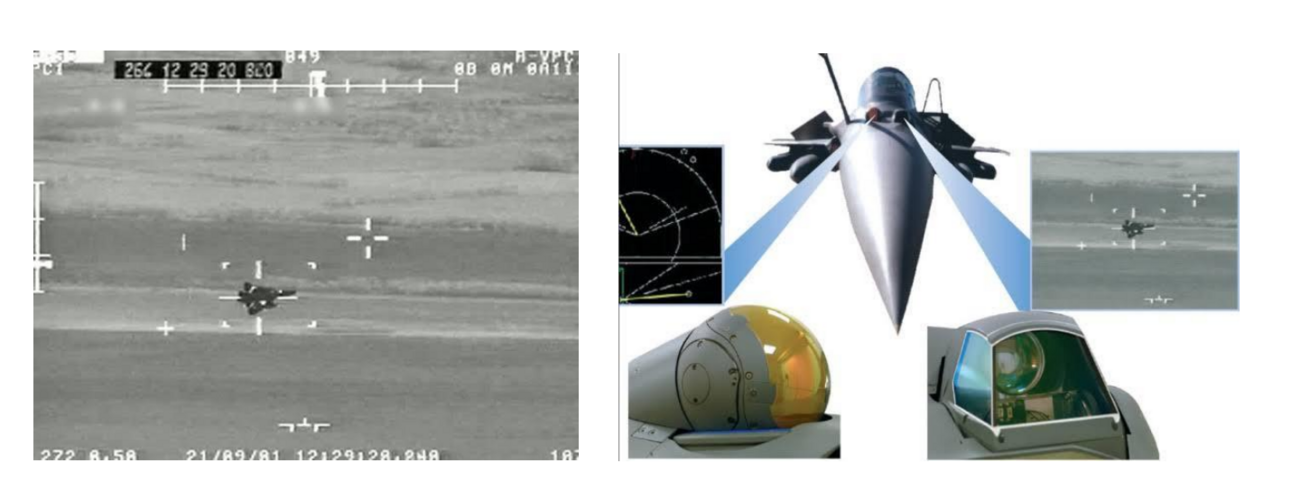
Joint Soviet Fighter
ACCESS: Secret
- Joined
- 14 January 2025
- Messages
- 247
- Reaction score
- 277
On the second photo it is a screenshot of the manufacturer's website for the "OAR" stating that it is in the IR range, the first photo describes the features of the system, one of which is video observation to warn of aerial objects(fighters) as well as missile warning, not as sophisticated as the F-35 DAS, but still gives you 360 degree detection in IR against fighters and such without usage of the IRST.
As for IRST capabilities, they usually do not form an image as a feature, doing this slows down detection and tracking, as they have to do enormous volume search, so an addition sensor channel is added for image capability, either black/white, color, or thermal. Rafale FSO actually splits these functions in two, one sensor for pure detection, other for identification. Russians combine them into one on both the Su35 and 57.
View attachment 758855
On older IRSTs they don't provide an actual picture, no, but more modern systems like the ones that we've mentioned & Pirate for The Eurofighter Typhoon do show actual footage via thermal imaging. Unfortunately, F-16.net seems to not be very cooperative, today, otherwise I'd hopefully be able to find the video from The OLS-35 that was much more like the older systems in that it was far more limited in the number of targets that could be tracked & the fact that they were displayed as nothing more than dots, iirc, so that's what I meant by there being a generational gap.
Assuming that you're correct about The Su-35, though, why would they not make use of the same iir technology from The MAWS in The OLS-35 or combine the two systems into one for the pilot? That makes absolutely no sense.
Joint Soviet Fighter
ACCESS: Secret
- Joined
- 14 January 2025
- Messages
- 247
- Reaction score
- 277
You're still not listening, so believe what you want, as I no longer care.You simply ignored the fact that Su-35 IR MAWS exists and prefered to bring completely unrelated case of the Soviet era tank modernization program.
In total, here is your fascinating logic: Su-57 has no IR MAWS cuz T-72B3 has no commander's IR-sight.
Are you a parody account?
*shrugs*
You still have your RWR.And if you cannot detect The SAM you have absolutely zero chance of evading it.
There are other ways to get within close range, low RCS is one of the method but not the only one. Another alternative is using drone with jamming capability like the MALD-X or SPEAR-EW. Russia can do something similarIronically, however, if you could field an aircraft with such an rcs that negates the radar advantage of The F-22/F-35, then that dogfighting capability would arguably make the difference in such a confrontation, but your rcs has to be at such a level so as to enable you to first get within the needed range.
Without a radar, then what advantage your stealth aircraft would have over 4.5 generation fighter?. They can use IRST too. And they are generally smaller.As for DAS vs uv sensors, I would personally opt for one system that provides the best of both worlds, so to speak, even at the expense of the two side looking AESA radars, for starters, or even not using an AESA, at all, with the idea being that when two truly stealth planes meet, radar becomes irrelevant, but, again, that's just me.
Also, the side looking AESA are mainly for SAR rather than air to air. I don’t see how DAS like system can replace it.
Ainen
I really should change my personal text
- Joined
- 25 August 2011
- Messages
- 1,237
- Reaction score
- 1,649
Side arrays(rear one is a bit of a mystery) are full power AESA, i.e. it is there exactly for "normal" query of priorities. SAR/GMTI is there, but only after the normal air to air(incl maws) and ew duties.Without a radar, then what advantage your stealth aircraft would have over 4.5 generation fighter?. They can use IRST too. And they are generally smaller.
Also, the side looking AESA are mainly for SAR rather than air to air. I don’t see how DAS like system can replace it.
Its size is relative. Compared to large fighter frontal arrays they're indeed small.
Compared to light fighter ones- not really; about half the TRM count.
They should be fully capable of providing combat-relevant detection ranges.
For EW purposes, for instance, it's rich even by NGJ standards.
Side arrays has about 40% T/R modules of APG-80 on F-16, so I find it to be pretty weak as an air to air radar. Though I can see some application for tracking close targets while beamingSide arrays(rear one is a bit of a mystery) are full power AESA, i.e. it is there exactly for "normal" query of priorities. SAR/GMTI is there, but only after the normal air to air(incl maws) and ew duties.
Its size is relative. Compared to large frontal arrays they're indeed small.
Compared to light fighter ones- not really; about half the TRM count.
Ainen
I really should change my personal text
- Joined
- 25 August 2011
- Messages
- 1,237
- Reaction score
- 1,649
Radar equation makes difference between bigger and smaller arrays disproportional, favoring smaller ones(relatively of course).Side arrays has about 40% T/R modules of APG-80 on F-16, so I find it to be pretty weak as an air to air radar. Though I can see some application for tracking close targets while beaming
There won't be say 5 times difference between big fronts and sides(matching trm count) for same rcs. Against low rcs targets and in safer LPI modes in particular, detection range difference will measure in relatively small values.
Ultimately, going toe to toe against any front array(even some light fighter air cooled ones) isn't the game. It's provision of tactically useful 360 deg situation awareness. DAS/IRST kind of logic.
Last edited:
yeetmahboi
ACCESS: Secret
- Joined
- 6 April 2022
- Messages
- 483
- Reaction score
- 574
SAMs on terminal maneuver will emit, unless it is an IR-based system (or command guided). IR MAWS plays into that by cuing the DIRCM system onto the seeker FOV.And if you cannot detect The SAM you have absolutely zero chance of evading it.
Truly fortunate indeed that it's just you.As for DAS vs uv sensors, I would personally opt for one system that provides the best of both worlds, so to speak, even at the expense of the two side looking AESA radars, for starters, or even not using an AESA, at all, with the idea being that when two truly stealth planes meet, radar becomes irrelevant, but, again, that's just me.
yeetmahboi
ACCESS: Secret
- Joined
- 6 April 2022
- Messages
- 483
- Reaction score
- 574
Cheek mount arrays gives you that juicy ability to track the target in unfavourable positions ie getting a lock on the RCS spikes. In WVR that's life and death.There won't be say 5 times different between big fronts and sides(matching trm count) for same rcs. Against low rcs targets and in safer LPI modes in particular, detection range difference will measure in relatively small values.
Ultimately, going toe to toe against any front array(even some light fighter air cooled one) isn't the game. It's provision of tactically useful 360 deg situation awareness.
Radar aperture area has a significant impact on radar range.Radar equation makes difference between bigger and smaller arrays disproportional, favoring smaller ones(relatively of course).
There won't be say 5 times different between big fronts and sides(matching trm count) for same rcs. Against low rcs targets and in safer LPI modes in particular, detection range difference will measure in relatively small values.
On normal array equation, it appear on both the area here and also affect the gain value.
On active electronic scanned array, it also affect the transmitting output (because there are more T/R modules on bigger array).
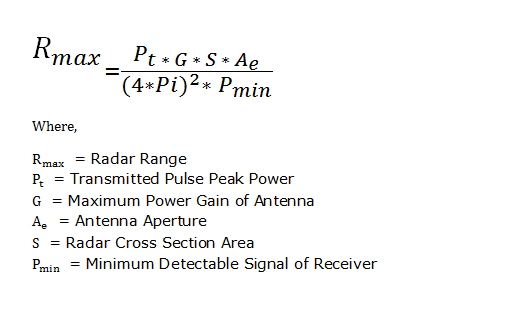
I just use the calculator by stealthflanker to make an example:
T/R modules quantity reduce by 74% then detection range reduce by about 63%
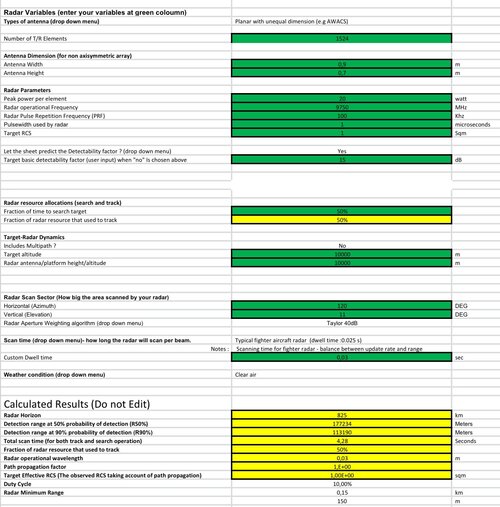
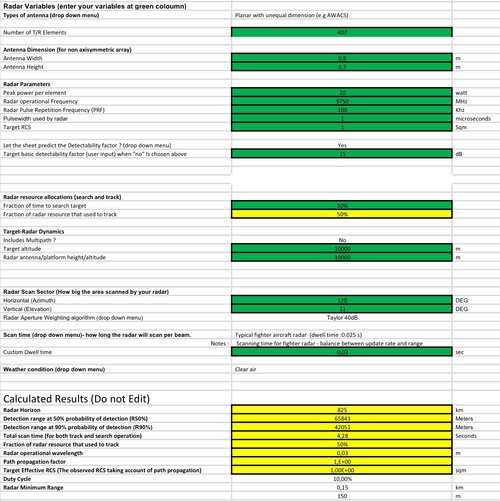
Yeah,I can see it. It's providing of tactically useful 360 deg situation awareness. DAS/IRST kind of logic.
Last edited:
That would be disappointing if true, especially as the usually very well informed folks at paralay's said it's a DIRCM (LSOEP). Do you have other images showing those sensors without the fairing to corroborate the above statement?That's not DIRCM, but the standard lower fore/aft MAWS sensor pair without its fairing.
Joint Soviet Fighter
ACCESS: Secret
- Joined
- 14 January 2025
- Messages
- 247
- Reaction score
- 277
And if it can't discern the difference between the frequency, etc., that is used by the opposing radar &/or seeker? Then what?You still have your RWR.
I guess, but I personally wouldn't bet the farm on that approach.There are other ways to get within close range, low RCS is one of the method but not the only one. Another alternative is using drone with jamming capability like the MALD-X or SPEAR-EW. Russia can do something similar
A much better rcs & constant passive surveillance of the battlespace via a DAS-like system. Is this not acceptable?Without a radar, then what advantage your stealth aircraft would have over 4.5 generation fighter?. They can use IRST too. And they are generally smaller.
if neither side use radar, then your advantage in RCS is pointless.A much better rcs
DAS is useful but it is not a long range system because it need to use wide FoV (unlike EOTS). Your enemy can use dedicated IRST with longer detection range than DAS such as OLS-35 or IRST21constant passive surveillance of the battlespace via a DAS-like system. Is this not acceptable?
Joint Soviet Fighter
ACCESS: Secret
- Joined
- 14 January 2025
- Messages
- 247
- Reaction score
- 277
You would really want to wait until the seeker goes active to find out that you're being targeted? That's a bold move, Cotton...SAMs on terminal maneuver will emit, unless it is an IR-based system (or command guided). IR MAWS plays into that by cuing the DIRCM system onto the seeker FOV.
It's definitely a tradeoff, but everyone has different priorities/views.Truly fortunate indeed that it's just you.
*shrugs*
Joint Soviet Fighter
ACCESS: Secret
- Joined
- 14 January 2025
- Messages
- 247
- Reaction score
- 277
That assumes that both planes have the same level of sensors & other technology, though.if neither side use radar, then your advantage in RCS is pointless.
The pilot can zoom in with DAS, iirc.DAS is useful but it is not a long range system because it need to use wide FoV (unlike EOTS). Your enemy can use dedicated IRST with longer detection range than DAS such as OLS-35 or IRST21
A Legion pod on F-16 probably has longer detection range compared to EOTS on F-35 or OLS-50 on Su-57 simply because it has much bigger apertureThat assumes that both planes have the same level of sensors & other technology, though.
You can but it just digital zoom. Whereas normal IRST system like OLS-35 or EOTS can zoom optically, so they can see further than DASThe pilot can zoom in with DAS, iirc.
yeetmahboi
ACCESS: Secret
- Joined
- 6 April 2022
- Messages
- 483
- Reaction score
- 574
And what makes that the MAWS on Felon can't home on the heat wake of an incoming missile?You would really want to wait until the seeker goes active to find out that you're being targeted? That's a bold move, Cotton...
yeetmahboi
ACCESS: Secret
- Joined
- 6 April 2022
- Messages
- 483
- Reaction score
- 574
The clutch about digital zoom is that it take the generated image and magnifies the pixels... That's all to it. As scale goes down so does clarity. Take a look through the M1A2 70x zoom.You can but it just digital zoom. Whereas normal IRST system like OLS-35 or EOTS can zoom optically, so they can see further than DAS
Ainen
I really should change my personal text
- Joined
- 25 August 2011
- Messages
- 1,237
- Reaction score
- 1,649
Also, while MAWS on su-57 is indeed Uv, there's also 720 IRST coverage.And what makes that the MAWS on Felon can't home on the heat wake of an incoming missile?
yeetmahboi
ACCESS: Secret
- Joined
- 6 April 2022
- Messages
- 483
- Reaction score
- 574
Your claim about RCS is dubious. Radar panels can be made flush with the skin ie B-2 attack radar. Aerodynamics has a much more profound impact on RCS. Fighters had solid nosecones way before radar was fielded in any significant quantity.A much better rcs & constant passive surveillance of the battlespace via a DAS-like system. Is this not acceptable?
DAS isn't a panacea. Optics can be fooled easier, and unlike radar they doesn't penetrate through weather. DAS also doesn't do ranging.
Joint Soviet Fighter
ACCESS: Secret
- Joined
- 14 January 2025
- Messages
- 247
- Reaction score
- 277
I'm talking about an inbound SAM, for example, that is no longer burning.And what makes that the MAWS on Felon can't home on the heat wake of an incoming missile?
Joint Soviet Fighter
ACCESS: Secret
- Joined
- 14 January 2025
- Messages
- 247
- Reaction score
- 277
I actually think that DAS could be better.Your claim about RCS is dubious. Radar panels can be made flush with the skin ie B-2 attack radar. Aerodynamics has a much more profound impact on RCS. Fighters had solid nosecones way before radar was fielded in any significant quantity.
DAS isn't a panacea. Optics can be fooled easier, and unlike radar they doesn't penetrate through weather. DAS also doesn't do ranging.
Joint Soviet Fighter
ACCESS: Secret
- Joined
- 14 January 2025
- Messages
- 247
- Reaction score
- 277
How's that?Also, while MAWS on su-57 is indeed Uv, there's also 720 IRST coverage.
Joint Soviet Fighter
ACCESS: Secret
- Joined
- 14 January 2025
- Messages
- 247
- Reaction score
- 277
Tell you what - as I tend to be more skeptical of Russian claims, can you show any pictures/video from The OLS-35, for example? I only ask as I don't think that I've managed to find anything.It does. As well as Su-35 MAWS. Clearly, you're satirical account...and not very smart one.
